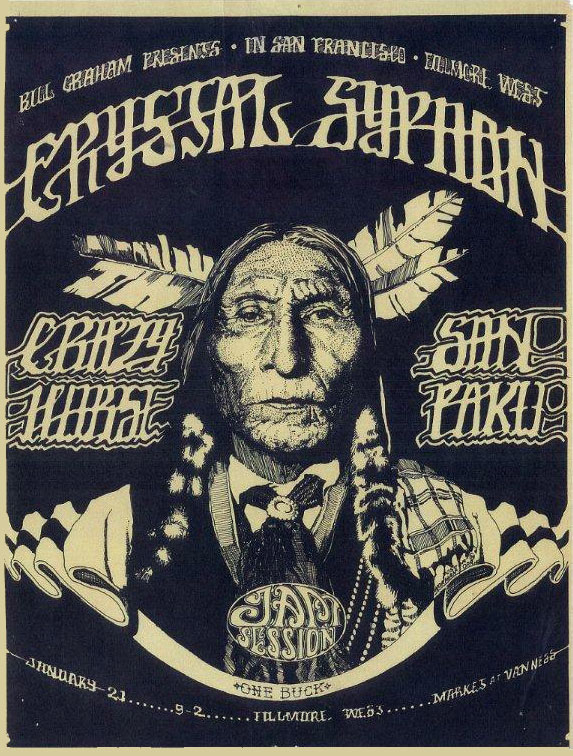
(Maurizio Galli – 2 settembre 2020)
Merced’s music scene
Merced is the county seat of the county of the same name located in Central California’s San Joaquin Valley. The City of Merced advertised itself as the “Gateway to Yosemite” because of its proximity to the famous natural park, and because the Yosemite Valley Railroad from Merced to the foot of the Yosemite Valley was the main tourist connection to Yosemite until the construction of all-weather highways into the Park in the late 1930s.
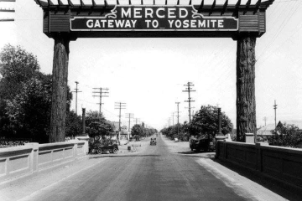
In the late 50s and the 60s, Merced was a town of about 20,000 people. At that time, it was fairly prosperous, with an economy based on agriculture but boosted somewhat by being the seat of government for the county, with the county courts, the sheriff’s office, jail, library, and all administrative branches based in the city. Merced also benefited at that time from the federal money that came to nearby Castle Air Force Base. The base, which closed in the 1990s, was the primary training center for US bomber and air tanker crews. As such, it had a permanent contingent of both military and civilian workers, and also a large rotating temporary contingent of air and ground crews. The permanent officers lived in Merced and Atwater, which added a layer of educated and traveled population which was not present in other San Joaquin Valley communities (and is largely absent from the city today). Merced was more cosmopolitan then than it has been in other periods of its existence. (Jeff Sanders)
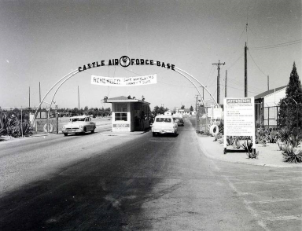
Unlike large cities, Merced had a decidedly limited “music scene”. Fortunately, however, being on Highway 99, the major north/south connecting highway on the West Coast at that time, many of the Rock’n’Roll and Rhythm’n’Blues groups traveling between San Francisco and Los Angeles stopped in Merced, with name groups playing almost every weekend. It seems that Jerry Lee Lewis, among others, stopped there for a concert.
There were four performance venues in the city: the American Legion Hall (on 17th Street), the Italo-American Hall (further west on 17th Street), the Women’s Clubhouse (on 23rd Street) and the Merced Fairgrounds (Merced has hosted the Merced County Fair since 1891).
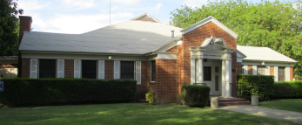
The American Legion Hall includes a bar on one side of the building, but it has a separate entrance for the bar. The bar could be open to the main hall for adult events, but the connecting doors were always closed during the dances for young people. The bar was and is almost exclusively frequented by veterans of the military. I don’t know if that was a requirement for entry or just customary. During the Vietnam War there was some hostility from the veterans of WWII and the Korean War in the bar towards the teens and hippies on the other side of the wall. (Jeff Sanders)
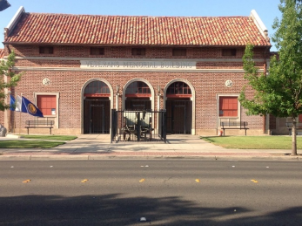
From 1963 to 1970, Merced’s music scene evolved into a series of dance concerts bringing the likes of The Doors, Jefferson Airplane, Quicksilver Messenger Service, Country Joe and the Fish, and Big Brother to the city. These shows were mostly promoted by Vince J. Lavery (VJ Productions) and Richard DeLong (Underground Explosion Calliope Company).
I started putting on dances and concerts in the Cental Valley of California – that is: Towns such as Merced, Livingston, Turlock, Los Banos, Modesto, Atwater, Castle Air Force Base, Le Grand, under the name ol “V.J. Productions” – Vincent J. Lavery. My first dance in The Legion Hall in Merced featured “The Eckos” which was made up of four airmen from the Air Force Base. Admission $1.25. September 1965 approximately. I ended, in late 1967, with the concert in the Strand Theatre in Modesto with Them, Van Morrison, Love, The Grass Roots and five local bands from Merced, Atwater, Turlock and Modesto. If I had put my dances and concerts on in big cities from San Francisco to Los Angeles to San Diego to Sacramento – I would have made a fortune. Bringing big groups to a town like Merced has had never been done before or since. Towards the end of the effort teenagers were travelling several hundred miles to attend. The first time “The Doors” played in Merced they drew 82 people – nobody had ever heard of them in the Valley on the day of their performance seven days later they were known nation wised because of their smash hit: – I think it was ‘Light my Fire’. (Vincent J Lavery)
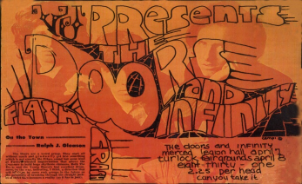
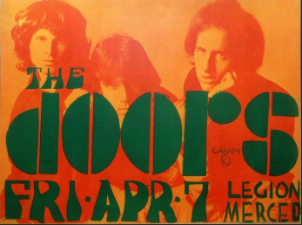
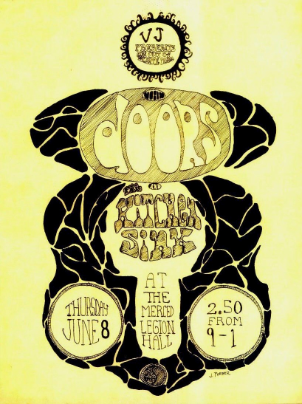
Many parents, church ministers and the police thought I was some kind of a ‘communist’ contributing to the delinquency of their children with this Satanic/drug infested music. Merced was a bastion of conservative politics – large corporate farm growers. (Vincent J Lavery)
Most of the local bands of the period followed a rather simple but well-tested formula: wearing matching stage clothes and performing covers by artists with radio hits, such as Freddy King and Magic Sam. Most of the songs were instrumental and in the case of songs with sung lyrics, they were often limited to being interpreted by a single member of the band.
The most important local band that emerged in that time was certainly The Merced Blue Notes, one of the very few bands that in the early 1960s consisted of a mix of African American and white musicians. – leading the band was George Coolures, the head of the local fire station.
The Merced Blue Notes were one of the first local and somewhat famous groups that I listened to in my teenage years. It was my first memory of wanting to play in a rock band, but at that time I only knew how to play the clarinet which was an instrument that no rock band seemed to use. As a result, I wanted to learn to play drums or guitar. (Jim Sanders)
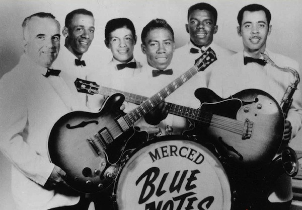
A musician, singer and songwriter who played in several local bands before being signed by Specialty Records was Roddy Jackson.
With his gravel-filled vocals and piano-pounding antics, Roddy Jackson was sort of a West Coast version of Jerry Lee Lewis in the late ’50s, and although his career never really took off into the stratosphere, his legacy is a solid one, and he is one of the last true rockabilly pioneers still out on the circuit. Born as George Roderick Jackson in California around 1940, Jackson fronted the multi-racial Blue Notes out of Merced, CA, beginning in 1956, but once signed to Art Rupe’s Specialty Records imprint, Jackson became essentially a solo act and none of the Blue Notes went to Specialty with him or played on any of his records, a situation Jackson was never really happy about. (The band, without Jackson, has one album out on CD as the Merced Blue Notes.)
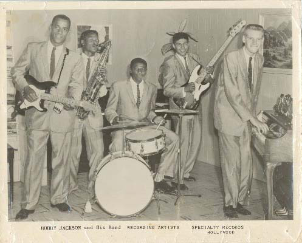
All this happened before 1964, the year the four Beatles landed in America. Once that happened, we know that things started to go in another direction.
After The Merced Blue Notes came The Brogues. The Brogues performed at the Women’s Club House or the Legion Hall on many weekends and were the first to show off a British Invasion sound in which echoes of The Rolling Stones and The Pretty Things were clearly evident.
The beginnings
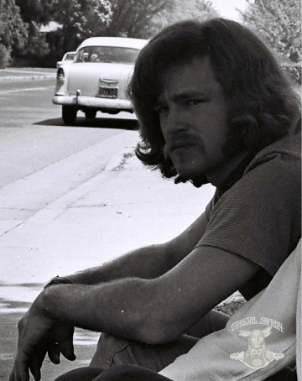
My mother and her family were thought of as musically gifted, but my mother and her sisters had their music careers and college experiences cut short by the Great Depression and the World War that followed. My oldest brother Bob did not play an instrument but became a locally famous radio disc jockey in the Elvis Presley era. My sister played the flute, my brother Jim learned clarinet, and I played trombone. (Jeff Sanders)
I was in a couple of high school talent shows singing in folk and rock one-time groups. There weren’t any auditions, and I don’t remember anyone asking me to join the band. I just kept showing up and they didn’t ask me to leave, so I was in. While I was politically very liberal and eventually looked like a hippie, I didn’t have a personal history that made local hippies accept me, and I didn’t share their somewhat mindless acceptance that everything hated by “normal” people should automatically be embraced as wonderful. It was not a great time for independent thinking, whichever side of the cultural divide you appeared to be on. The flavor of my experience in those times is reflected in the lyrics of a number of our songs, which are not the most positive among our contemporaries. So over time I was in Crystal Syphon and later in bar bands playing drums and singing. I moved to Los Angeles in the mid-1970s and worked in the recording business, where I became a very busy mastering engineer (creating the masters for vinyl records). Much later, in 1989, I moved back to Merced, where I taught English and History, and helped raise two children. As time passed, I accumulated some live sound gear (and percussion gear, and recording gear), and started recording and mastering music again. I worked on the first Crystal Syphon CD, where the surviving band members met again and started playing together. To my surprise, the circle is, while beaten a bit out of round, still unbroken. (Jeff Sanders)
When I was in high school, many of my friends had guitars, acoustic and electric. John Rohde, for example, had a Japanese imitation of the Fender with more pickups than a NASCAR car park. John knew how to play ‘Wipe Out’, the opening riff was my first triumph with the guitar. With John, who also had an amplifier with reverb and tremolo, sometimes after school we would go around for hours playing that one song. (Jim Sanders)
I grew up on a ranch in the country outside of Merced. Until the age of 13 my only time to hear live music was at the Fair which was a yearly event. That is where I first saw The Merced Blue Notes, who had a number of R and B instrumental recordings. They were an inspiration to me. The school bus I rode home each day had many of that band’s brothers on it and I became friends with them. We’d talk Blue Notes and had school book tapping rhythmic jam sessions all the way home. I also listened to Ray Charles albums a lot. In 1963 when I was 13 I got a guitar for Christmas and my world took a major turn. All I wanted to do was play guitar. Before that year was over I was playing guitar at school and backing up my school choir. The Beatles were coming out and I learned all their songs. In high school there bands playing a venues around town. The Pendeltons, Tokays, and The Brogues to name a few. The Brogues made the biggest impression on me. They played the British invasion songs and sounded authentic at it. The Brogues broke up when the lead guitar player was drafted. The lead singer and the drummer moved to the Bay Area and formed Quicksilver Messenger Service. I would connect with them a few years later. (Tom Salles)
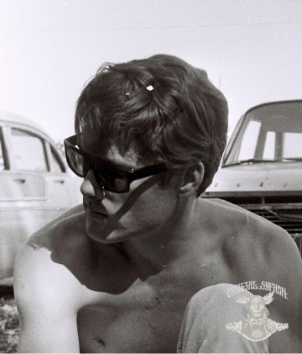
I will not get into family history, but I will tell you I was a huge Elvis fan at the ripe old age of seven. I played his music all day everyday and I sang along with it. I watched all his movies and I wanted to be Elvis when I grew up! I’m surprised that I can sing his stuff and sing all the higher harmony stuff that we do. I decided early that I wanted to be a singing movie star and enrolled in drama classes starting in fourth grade. I told the teacher that I wanted the lead part in every play and would like to sing if the play required that. My first play required me to learn the harpsichord and sing a couple of Irish songs. I continued into my sophomore year in high school acting and singing in every play I could get into. In my sophomore assembly I played the piano and sang “Girl From Epanema” which everyone thought I lip synced. I was pissed. The whole audience thought it was not live! Anyway, after that, Andy Daniels approached me to see if I would be interested in joining a band. The rest is history! Unfortunately my goal of becoming a rock star never happened, we have another chance of making that happen. We have many positive reviews from around the globe and I’m not going to give it up! (Dave Sprinkel)
WITHOUT NAME # 1 – Folk-band (from spring 1965)
Jeff Sanders (vocals, tambourine), Jim Sanders (vocals), Bob Hesse (vocals, acoustic guitar), David Gresham (vocals)
Folk music was very popular, so in the spring of 1965 Jeff Sanders (Merced, California 13 September 1948) together with his brother Jim (Merced, California, 17 April 1947) decided to put together a band to play during the Merced High School Hootenanny (April 1965). In addition to Bob Hesse on guitar, David Gresham joined the group.
Dave Gresham and I were classmates from middle school through high school. We have remained life long friends. All four of us knew each other and were friends in High School. Jeff, Hesse and I played football (American football, ndr) together. (Jim Sanders)
When our family moved from the farm into the City of Merced, I went to Fremont School in the fifth grade. Early in the year everyone took an intelligence test and based on a high test score I was put in a half-day class at a different school. It was called the Rapid-Learners class. It gathered students from all of the city’s schools into one class for “advanced” education. I came from Fremont School, and Bob Hesse came from Charles Wright School. Bob Hesse and I became friends in that half-day class. We were also put in a lot of the same classes in Junior High School and High School. We all played American Football. (Jeff Sanders)
April 1965 – Hootenanny Merced High School, Merced, California
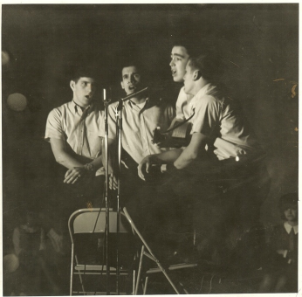
The folk experience lasted just enough time for our group to compose an original song ‘Shiloh’ (written by Bob Hesse, Jim Sanders and Bob Sanders, ndr) and to perform a few more times besides the Hootenanny.
After the brief folk moment came the goal of playing at a high school dance and so Jim Sanders pushed to add to the vocals and guitars a rhythm section, bass and drums.
Jim, who graduated from high school in the meantime, made friends with guitarists Steve Chastain and Dan Cresci, with them he started jamming until they even played at a couple of parties. However, the real turning point in his musical life came thanks to the fortuitous encounter with Tom Salles, and to their shared passion for Beatles records. They first met at Record Rendezvous, the local music and record store (355 West 17th Street, Merced, California).
I had previously seen Jim play with a group on the school’s talent show before it ended. We started talking and soon we found ourselves tinkering a bit with the music. With him and Dave Sprinkel I started playing together. We also played at a student dance with Richard Hogan on bass and if I remember correctly Andy Daniel. From that time on he joined us on drums. To tell the truth I’m not absolutely sure that Andy was the drummer on that occasion but in any case he joined us shortly after with Roger Henry as bassist. We had become the embryo for the Morelochs. (Tom Salles)
WITHOUT NAME # 2 (after the summer of 1965)
Jim Sanders (guitar), Tom Salles (lead guitar), Dave Sprinkel (organ), Richard Hogan (bass), Andy Daniel (drums)
After the folk experience and before the birth of the Morelochs there was the first experience as a rock quintet. The lineup is basically the one that will remain stable for some time (apart from the future entry of Jeff Sanders and the change of the bass player).
I had to borrow a Fender Mustang guitar from a friend, and an amp from another friend. Dave rented a Farfisa organ from Record Rendezvous, and Hogan had his own bass and Andy had his own drum kit. That was the only gig we did with that line up, except maybe a party at somebody’s house until Long Beach. Roger later quit the group and joined the Navy. (Jim Sanders)
In my sophomore year I sang ‘Girl From Ipanema’ and ‘Hey Jude’ in the class assembly which was basically a talent show that every class organized for the rest of the school. A couple of days later I was approached by our drummer, Andy Daniel, who said they were putting together a group and wanted me to join them. We did our first tests at our friend’s house but it didn’t last long and so we ended up definitely at the home of Jeff and Jim Sanders’ parents. We practiced in their living room while the parents sat reading their newspapers. It’s amazing how much patience they had! (Dave Sprinkel)
Dance at High School
House Party, Long Beach, Los Angeles, California
MORELOCHS (November 1965)
Jeff Sanders (vocals, percussion), Jim Sanders (rhythm guitar, vocals), Tom Salles (lead guitar, vocals), Dave Sprinkel (vocals, organ, tambourine), Roger Henry (bass, vocals), Andy Daniel (drums)
I remember having a meeting at Andy Daniel’s parents’ house immediately after he joined the band as a drummer. We later added Roger Henry as a bass player. His family lived two blocks from my parents’ house and his older brother, Del, let Roger use his Fender Precision Bass and Showman amplifier. Roger, in addition to being able to sing and play bass, had an interesting personality even if he didn’t seem to engage much with the band. I’m almost convinced that he got bored long before he left the band. Justin Brink, who sometimes sang with the folk group, at some early point decided that he no longer wanted to be part of the group. I don’t remember if it was because of the little free time he had or if he didn’t like the direction we were going. Bob Hesse quit soon after because he wasn’t interested in playing the electric guitar or being in a rock band, although he loved music and was a fan of the early Beatles. At that point we added Tom Salles to replace Bob Hesse on guitar and vocals. Tom for his part brought with him the ability to play solo lead guitar and to sing very high harmony parts. He had a unique voice and is the main voice on some of our early songs. Dave Sprinkel was added to the band because we wanted to have a keyboard player, and he was the only person of our age who seemed to be able to play keyboards. He also had (and still has) a very good voice, an ability to sing harmony, and an unusual talent for taking poems and making the poetry fit as lyrics of a song. He also contributed lines and words while others were writing songs. That’s how we moved from the small folk line-up to six rock musicians … five singers, drums, two guitars, organ and bass, the Morelochs. (Jeff Sanders)
Although memories vary a bit, it seems that the name of the band, Morelochs, was chosen on the occasion of their first real performance, in November 1965, in a hotel in Long Beach, California during the Long Beach High School Band Review (All-Western Band Review).
I think we all saw the movie “The Time Machine” on television at the same time. I was at home and I can’t remember who I called, I think it was Jim. I asked him ‘What do you think of Morelochs? He replied that he too was watching the same film and that we would talk about it with the other boys. Another couple of them were also watching the film and agreed with the idea. On second thought it was a rather strange name! But it created a lot of ‘What does that mean?’ conversations. (Dave Sprinkel)
The band got its name from the movie ‘The Time Machine’. I don’t remember why that name struck us, but it did. The film was shown on TV one evening and the next day we were the Morelochs. We became very popular in the Merced, Modesto, and Fresno area. Not that we were as good as the Brogues, but they had split up and we managed to fill the niche they created as the Merced band. This has in some sense played to our disadvantage because there were other bands trying to do concerts, but we were getting them all and this caused some resentment. (Tom Salles)
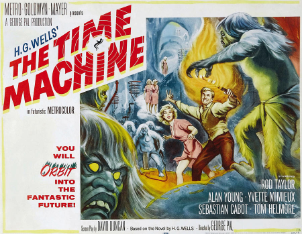
The Morelochs were great at Beatles covers as we had 5 members who could sing and we nailed the group harmonies. We became a very popular group locally and soon had all the gigs such that we became very disliked by the other groups because we’d get all the gigs. (Tom Salles)
To rehearse at their home, Jeff and Jim’s parents gave us 9/10:00 PM as a curfew because mother Anna was studying to qualify for teaching while their father Marvin was working in an insurance company. In addition to this, they helped us a lot and often allowed us to leave our equipment in their home. Rehearsals and concerts were initially a real challenge for us because we did not have adequate musical equipment. The guitars and amps were really poor while the good things we had were usually borrowed for the day. We started to get good quickly, we had four good singers, who could sing harmonies and solos, while most of the bands at the time had one or sometimes two. (Tom Salles)
When the folk group and the band started, Jim and I were in high school and lived at home (224 East 21st Street). We rehearsed the band in the living room of that house for some time. Our parents were very tolerant and supportive of the band, which was rare, especially as the years progressed into the San Francisco era when most people of their generation in Merced were intolerant and negative to various degrees. But practicing at that house was problematic. Getting equipment in and out took time, especially when we bought the three Vox Super Beatle amps, which with their attached roller stands were each almost the size of an American refrigerator, not like the suitcase-sized Fender amps we owned previously. The house was three or four steps up from street level, so the large roller stands of the speaker boxes were difficult to maneuver in and out. Jim may have some pictures of the house at that time. He (Jim) remodeled it for my parents after the band was long gone. Between moving in, setting up, taking down and moving out drums, amps, microphones and a PA system each time we rehearsed, it felt like we spent more time moving equipment than we did rehearsing. That’s why we were very pleased when Lynne Meredith got us into the Shannon building. And as I wrote to you before, rehearsing in an acoustic space similar to the halls we played in eliminated the jarring difference between the sound of the band in a garage or living room and the sound of the band in a performance space. (Jeff Sanders)
Robert M. “Bob” Sanders, the older brother of Jim and Jeff, offered to manage the band, thus allowing the musicians to focus exclusively on the creation, writing and recording of original material. Bob also managed to finance the purchase of some equipment the band needed, Fender amps, better guitars, and later three large Vox Superbeatle amps. This allowed the band to start playing for some of the local promoters.
At that time Jeff, Jim, Dave and Tom started writing songs or meeting during rehearsals with fragments of songs and then processing them together.
My brother Bob has written poetry throughout his adult life, he was in Merced at the time of the Morelochs and he gave us the lyrics for some of the songs that we then recorded. Usually Tom and Jim took care of putting his words into music. (Jeff Sanders)
In this regard it is good to remember that before the psychedelic scene in San Francisco, the young bands used to borrow the songs on the singles of the most popular groups at the time. In the student dances on Friday after American football games, and in those on the weekend at The Womens’ Clubhouse (or at the Italo-American Hall, or the American Legion Hall) the bands played the hits of the Beatles, Animals, Rolling Stones, Byrds … basically anything successful that was on the radio at the time.
There were a few places in town where the new bands played at dances. The places were; The American Legion Hall, and The Womens’ Clubhouse. There were other venues that were used very rarely at that time. These were places that were not bars and did not serve alcohol, so the crowds were predominately under 21, and more often 12 to 18. The Tokays were a Merced band that overlapped the Elvis/Beatles era. They were playing in 1965, but by 1967 they seemed to be gone or had changed names. Mag was a promotion group from Fresno, not a band. Mag may have originally been a car club in Fresno that started putting on dances there, but I’m not sure of that. So Mag dances in Merced usually had Fresno bands, but occasionally included a local band. I don’t remember that we ever played at a Mag dance, but we might have. ‘Fresno Rock’ is probably a butchered reference to Fresno bands playing in Merced. There were a few that played regularly at the venues mentioned above and that also were booked for high school dances and the high school prom. I’d have to have my memory bumped to recall Fresno band names. In addition to Mag, local promotion groups and individuals started sponsoring dances. VJ Productions (Vince Lavery) was one, the others were groups of teenagers seeing a chance to make some money. As this scene turned more toward a San Francisco focus, there were additional groups attempting promotions and also local light show groups trying to get booked at these dances. (Jeff Sanders)
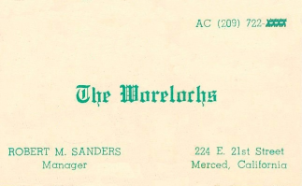
November 1965 Long Beach, Los Angeles, California
First performance as Morelochs during the Long Beach High School Band Review (All-Western Band Review)
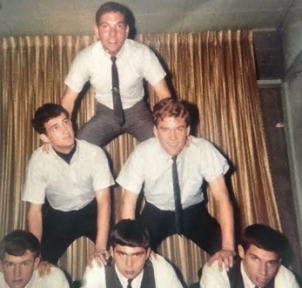
Andy, our drummer, was in the Merced High School Marching 100, which was the school band (the Merced High School Marching 100 concerts were held every spring at the Merced Theater on Main and now Martin Luther King). Every year, the band, majorettes, flags and letters travelled south to compete in the Long Beach Band Review. Andy talked the band boosters (the parents’ group) into hiring our band to play at a dance for the band members in the little ballroom at the top of the hotel where they were staying. Jim built a little PA system which we packed in the huge trunk of the Chevy Impala that we borrowed from brother Bob. The amps and some of the band travelled in another car. People from other places often don’t realize how large California is. Long Beach is 300 miles south of Merced. Luckily, gas was only 30 cents per gallon in 1965. (Jeff Sanders)
Merced High School
Our Lady of Mercy School
Our Lady of Mercy Catholic School hosted weekly dances known as the ‘OLM Dances’, that featured many bands from the local area. We had the opportunity to do 1 or 2 of these engagements. (Tom Salles)
December 21, 1965 Stockton Garage Studio
Merced’s sextet went to a Stockton “garage studio” to perform their first recording session (“garage studio” is a term that describes any makeshift recording studio in a space not designed as a studio). On that occasion they recorded: Day Tripper, Help Me, And I Will Love You, You Hurt Me, I Don’t Know Why I Cry and I Didn’t Mean To Hurt You.
We first recorded in a terrible studio in Stockton. We recorded the Beatles ’Daytripper’, which we thought we played really well. We made a terrible recording. We didn’t even have all the correct words to the song. The guitars sound like Japanese koto, it is awful. (Jeff Sanders)
We recorded first at a garage studio in Stockton, and at Dick Tersian’s studio in Fresno. Our very first studio recordings were unreleasable because they were simply horrible. We thought we were ready, but our first recordings informed us that we weren’t. We had work to do on songwriting and performance, but there was also ignorance of the art and science of recording involved in our lackluster early studio product. There is unending complexity in recording and mastering, and I had to become a mastering engineer eight years later before realizing specifically why our demos didn’t sound as good as label releases. Being prone to self-doubt, I had assumed that the fault was with the band, either in writing or performance. In hindsight, our very best studio recordings were only demo quality, and were not mixed with any seriousness. Some of the mixes have so much reverb added that some of the words are unintelligible. Our acetates were just flat transfers to disc of those mixes on medium-quality mastering equipment. The thought that someone could or should optimize each step and polish our mixes or make an acetate that was competitively loud or bright never occurred to us. that was another instance when our distance from any center of recording knowledge hindering our progress. (Jeff Sanders)
Our first recordings were made in a poor studio in Stockton. Inside a garage. I don’t remember the name of the studio, but it wouldn’t surprise me if it didn’t have one. I remember being really disappointed with the sound of my guitar. At that time I was playing a Fender Jazzmaster and the guy from the studio made my solos sound like I was playing on fence cables, heavy attack and without decay. (Tom Salles)
Jobs Daughter’s / Demolay Dance, The Masonic Hall, On the corner of 18th and M streets, Merced, California [date to be defined]
Job’s Daughters International is a Masonic affiliated youth organization for girls and young women aged 10 to 20.
We played there once as the Morelochs for a Jobs Daughter’s/Demolay dance. Not sure the date but early in Morelochs performances. (Jim Sanders)
Those 1960s dances were open to the general public and had nothing directly to do with Freemasonry. It was a little hall with a stage. I think it stopped being used for dances because it was too small to generate enough money to pay the band and provide a profit. It is also possible that the Masons decided to stop making the hall available, but I never heard that. (Jeff Sanders)
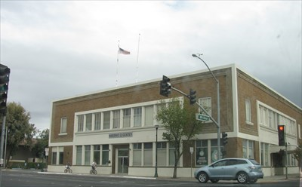
Circus Room dell’Hotel Tioga, Merced, California [date to be defined]
The Circus Room overlooked N street and was north of the hotel’s main entrance.
As far as I can remember, the Circus Room had decorations that suggested the inside of an old-fashioned circus tent. I think it was a banquet/conference room with a connecting door to the lobby and a connecting door to the bar. (Jeff Sanders)
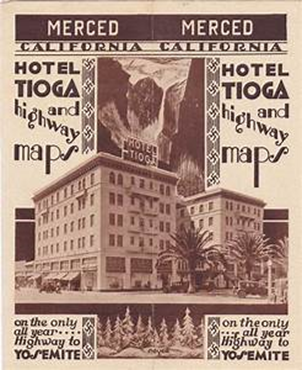
This image is notable for two things. First, this 1920s poster is decorated with swastikas. That symbol is so rare today that it’s shocking to see. Also, in the lower right right corner of the hotel in the original photo there is a awning or canopy in front of the north space. The logo on the awning says ‘Coffee Shop’. So, in the original configuration, the last room next to the alley is the restaurant/café. The Circus Room and the bar were, probably, the other two rooms. (Jeff Sanders)
April 1966 American Legion Hall, Merced, California
Performers: Golliwogs, Morelochs
The first real Morelochs concert performance, not one of the usual parties or school dances, took place in April 1966 at the American Legion Hall in Merced with the Golliwogs, a band that in November 1965 had released the single “Brown Eyed Girl” and that, about a year later, would change its name to become the much more famous Creedence Clearwater Revival.
I do remember that the Golliwogs showed up with a rented PA system. They had been an instrumental backing group for traveling singers in the Bay Area before their single “Brown Eyed Girl” (which is a completely different song than the one Van Morrison recorded with the group Them). Their PA system had tiny no-name speaker boxes and they had Shure ribbon microphones. The Shure ribbons were decent announcer mics but were horrible for rock vocals. That PA system sounded terrible. We set up our system and tested it before our first set. John Fogerty asked if The Golliwogs could sing through our system, and both bands used our system. (Jeff Sanders)
What was unique about this gig was at the end of the show we had gotten on well with the band and actually exchange business cards and traded autographs. (Tom Salles)
April 5, 1966 Victory Studio, Fresno, California
Given the bad experience at the Stockton Garage Studio, the Moreloch decided to opt for Victory studio in Fresno, owned by Dick Tersian, for the recording of their songs: Shady Woman, You Hurt Me and She Won’t See Me (Help Me) while ten days later (April 15, 1966) Day Dreamin and I’ll Take Two were recorded there.
We recorded twice in Fresno, at a studio that was a lot better than we thought it was at the time. The owner/engineer was Dick Tersian, and the equipment was first rate. Ampex tape machines, Neumann microphones, Altec monitors. (Jeff Sanders)
In addition to experiences in the recording studios, 1966 was a year focused on live performances and the improvement of the songwriting and performing skills of the band.
We also participated in one or two Battle of the Bands held in the parking lot of the local record store during the summer. I think we won once, but not sure. (Jim Sanders)
We did play at two (I think) battle of the band events. I don’t think we won any battle of the bands, but we met and heard a lot of local musicians at those events. I think I first saw Bob and Marvin Greenlee at a battle of the bands, but that’s not a clear memory. One of those battles was won by Jesse and the Jades, which was a Latino (Mexican-American) rock band. There were at least a few Mexican-American bands that were popular at the time. Those “battles” were a method to be seen when a band was starting out. After we had played some school dances and were starting to be known, we didn’t need to be in any battles. (Jeff Sanders)
July 29, 1966 Mercy Gulch Days, Merced, California
Mercy Gulch took place during the summer roughly a week before the County Fair. For the occasion, the band, which had just purchased most of the instruments, performed on the back of a trailer or flatbed truck parked in front of the Willis Appliance Store on 17th Street (now called Main Street).
The Mercy Gulch performance was as fun as it looks in the photograph. The picture of the crowd and the band offer an excellent insight into that year. At that time we were still trying to be the Beatles, and the crowd was starting to be post-Beatles and pre-hippie. (Jeff Sanders)
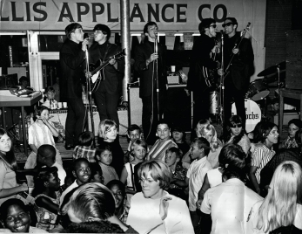
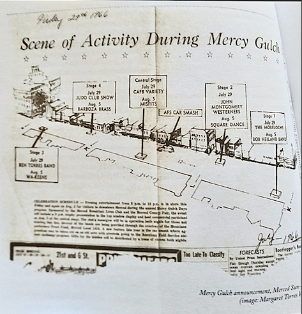
July 1966 Fairgrounds, Merced, California
Our performance at the fair was terrible. The drummer’s kick drum pedal broke at the beginning of the performance and this hindered us for the rest of the performance. Also, since we had almost no experience in handling any problems during our performance we lost time and interrupted the show with many internal discussions like ‘try this … try that … try to repair the pedal …’. (Jeff Sanders)
Summer 1966 Women’s Club House, Merced, California
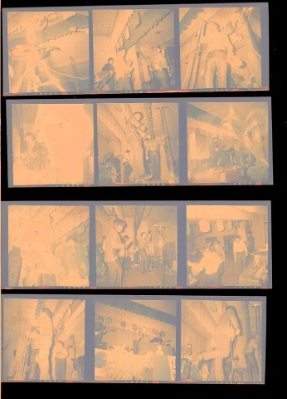
However, it must be said that the future Crystal Syphon had a trump card on their side:
We had a secret weapon that helped make us the best copy band in Merced at that time. Our brother Bob was a disc jockey at KYOS, the local pop radio station. Because he worked there, he could listen to all of the new records that were sent by record company promotion men who were trying to get their artists played. So, for example when The Beatles’ “Paperback Writer” was sent to radio stations a week in advance of its Friday release date, Bob would get us a copy of the song on Saturday. We would learn the song, rehearse it a few times, and at a dance on Friday, the evening of the same day it was first played for the public, we could perform a very good version of the song. No other band could do that. The other local copy bands never asked how we did that or seemed to figure it out, and some of the people in other bands started to hate us, which is not an unexpected result of competitive success. (Jeff Sanders)
Before the San Francisco bands began to attract public attention outside the San Francisco Bay area, the Morelochs were labeled a pop cover band. Soon there was a rumor in Merced that there was a cultural movement and a musical revolution going on in the Bay Area at the Avalon Ballroom and the Fillmore Ballroom, and most of the local bands wanted to be part of it.
Purple Turnip, 10th St., Modesto, California [date to be defined]
One of the last concerts as The Morelochs
I remember playing there and believe the place was owned by Al Ward, from Al Ward and the Epics. He was a regionally known sax player who had a cover band. I remember seeing a poster on the wall advertising a previous performance at that club by the Warlocks which was the name of the group that later became The Grateful Dead. Al Ward was also the band in the early 70’s who we took their gig away as Boogeyman at Manjo’s in Turlock. (Tom Salles)
To be continued…
AUTHOR’S THANKS
Jeff e Jim Sanders, Tom Salles, Dave Sprinkel, James (Roaratorio Records), Ross Hannan, Klemen Breznikar (www.psychedelicbabymag.com), Sarah Lim (Merced County Courthouse Museum), Michael Kennedy (mercedmusic.wordpress.com), Aldo Pedron, Vincent J Lavery (A.K.A. “V.J.”), Corry Arnold (http://rockprosopography101.blogspot.com/), Jason Ankeny (for Norman Orr biography), Modesto View (www.modestoview.com)
